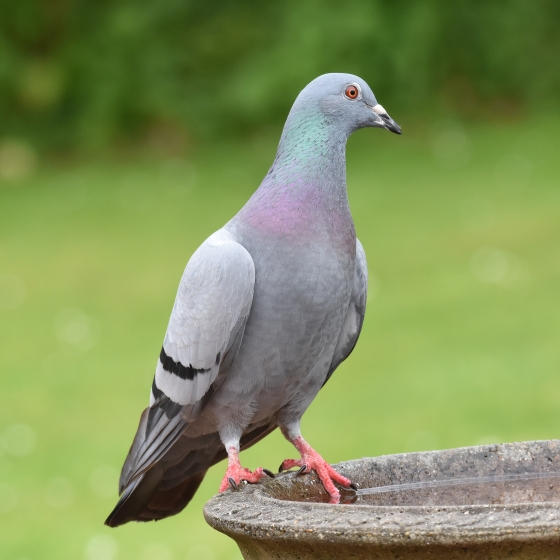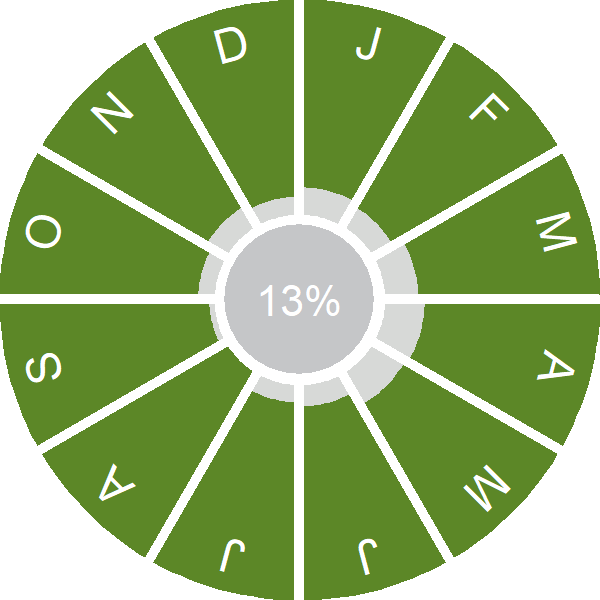Rock Dove
Columba livia (JF Gmelin, 1789)
DV
 ROCDO
ROCDO  6650
6650

Family: Columbiformes > Columbidae

If you were searching for Feral Pigeon you have been redirected to our Rock Dove page because this species is the ancestor of the Feral Pigeon.
- You can find information about both Rock Doves and Feral Pigeons on this page.
- You can learn more about both birds in our blog, Wild Rock Doves: solving a genetic enigma.
A deep-red eye, pale-grey plumage, two black wingbars and a white rump make the Rock Dove a beautiful bird.
The Rock Dove is the ancestor of the Feral Pigeon, but truly wild birds occupy a very different setting to their urban cousins. Wild Rock Doves are confined to our northern rocky coasts and islands and nest in sea caves and on steep cliff ledges, whilst Feral Pigeons use a range of human structures, from windowsills to the underside of bridges.
Wild Rock Doves are ringed as part of the Ringing Scheme, results from which reveal that they can live to over seven years of age and, unlike their racing relatives, rarely move very far.
Identification
Rock Dove identification is often straightforward.
SONGS AND CALLS
Listen to example recordings of the main vocalisations of Rock Dove, provided by xeno-canto contributors.
Call
Song
Develop your bird ID skills with our training courses
Our interactive online courses are a great way to develop your bird identification skills, whether you're new to the hobby or a competent birder looking to hone your abilities.
Browse training coursesStatus and Trends
Population size and trends and patterns of distribution based on BTO surveys and atlases with data collected by BTO volunteers.
CONSERVATION STATUS
This species can be found on the following statutory and conservation listings and schedules.
DISTRIBUTION
Pure Rock Doves are thought to be restricted to remote coastlines of north and west Scotland and north, west and south Ireland. Elsewhere, birds resembling Rock Doves occur in many Feral Pigeon flocks. Owing to the difficulty of assigning such individuals to each form the maps here combine Rock Doves and Feral Pigeons. The resulting maps show this resident species to be widespread in Britain, though largely absent from the uplands of central Wales, northwest England, the Southern Uplands and Scottish Highlands. In Ireland it is found mostly in the east and south, and is absent from large parts of the midlands.
Occupied 10-km squares in UK
| No. occupied in breeding season | 2362 |
| % occupied in breeding season | 78 |
| No. occupied in winter | 2460 |
| % occupied in winter | 81 |
European Distribution Map
DISTRIBUTION CHANGE
Change in occupied 10-km squares in the UK
| % change in range in breeding season (1968–72 to 2008–11) | +46.1% |
| % change in range in winter (1981–84 to 2007–11) | +22.1% |
SEASONALITY
Rock Doves (and Feral Pigeons) are recorded throughout the year.

Movement
Information about movement and migration based on online bird portals (e.g. BirdTrack), Ringing schemes and tracking studies.
RINGING RECOVERIES
View a summary of recoveries in the Online Ringing Report.
Biology
Lifecycle and body size information about Rock Dove, including statistics on nesting, eggs and lifespan based on BTO ringing and nest recording data.
SURVIVAL & LONGEVITY
View number ringed each year in the Online Ringing Report
Maximum Age from Ringing 
|
7 years 8 months 25 days (set in 2010) 
|
Typical Lifespan 
|
3 years with breeding typically at 1 year |
Adult Survival 
|
0.665±0.049  
|
Juvenile Survival 
|
0.57 (in first year) 
|
BIOMETRICS
Wing Length 
|
Adults | 229.3±7.1 | Range 218–241mm, N=58 |
Body Weight 
|
Adults | 360±43.1 | Range 299–441g, N=57 |
Feather measurements and photos on featherbase 
CODES & CLASSIFICATION
Ring size 
|
E |
Field Codes 
|
2-letter: DV | 5-letter code: ROCDO | Euring: 6650 |
For information in another language (where available) click on a linked name
Links to more studies from ConservationEvidence.com
- Possum control and bird recovery in an urban landscape, New Zealand
- The incidence of the parasitic disease trichomoniasis and its treatment in reintroduced and wild pink pigeons Columba mayeri
- Exterior nest-boxes may negatively affect barn owl Tyto alba survival: an ecological trap
Read more studies about Rock Dove on Conservation Evidence >
Would you like to search for another species?











Share this page